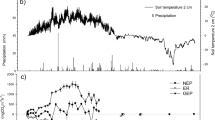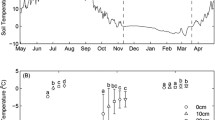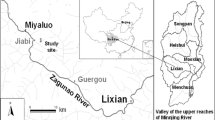Abstract
Fluxes of CO2 and N2O were measured from both natural and experimentally augmented snowpacks during the winters of 1993 and 1994 on Niwot Ridge in the Colorado Front Range. Consistent snow cover insulated the soil surface from extreme air temperatures and allowed heterotrophic activity to continue through much of the winter. In contrast, soil remained frozen at sites with inconsistent snow cover and production did not begin until snowmelt. Fluxes were measured when soil temperatures under the snow ranged from –5°C to 0°C, but there was no significant relationship between flux for either gas and temperature within this range. While early developing snowpacks resulted in warmer minimum soil temperatures allowing production to continue for most of the winter, the highest CO2 fluxes were recorded at sites which experienced a hard freeze before a consistent snowpack developed. Consequently, the seasonal flux of CO2 –C from snow covered soils was related both to the severity of freeze and the duration of snow cover. Over-winter CO2 –C loss ranged from 0.3 g C m−2 season−1 at sites characterized by inconsistent snow cover to 25.7 g C m−2 season−1 at sites that experienced a hard freeze followed by an extended period of snow cover. In contrast to the pattern observed with C loss, a hard freeze early in the winter did not result in greater N2O–N loss. Both mean daily N2O fluxes and the total over-winter N2O–N loss were related to the length of time soils were covered by a consistent snowpack. Over-winter N2O–N loss ranged from less 0.23 mg N m−2 from the latest developing, short duration snowpacks to 16.90 mg N m−2 from sites with early snow cover. These data suggest that over-winter heterotrophic activity in snow-covered soil has the potential to mineralize from less than 1% to greater than 25% of the carbon fixed in ANPP, while over-winter N2O fluxes range from less than half to an order of magnitude higher than growing season fluxes. The variability in these fluxes suggests that small changes in climate which affect the timing of seasonal snow cover may have a large effect on C and N cycling in these environments.
Similar content being viewed by others
Author information
Authors and Affiliations
Additional information
Received: 5 April 1996 / Accepted: 25 November 1996
Rights and permissions
About this article
Cite this article
Brooks, P., Schmidt, S. & Williams, M. Winter production of CO2 and N2O from alpine tundra: environmental controls and relationship to inter-system C and N fluxes. Oecologia 110, 403–413 (1997). https://doi.org/10.1007/PL00008814
Issue Date:
DOI: https://doi.org/10.1007/PL00008814




